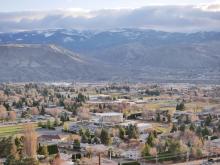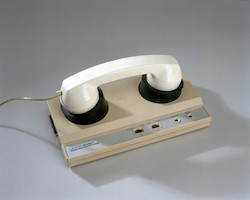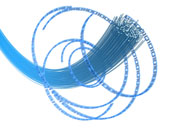
Fast, affordable Internet access for all.

Washington's Douglas County Community Network (DCCN) began as a way to improve the local Public Utility District’s electric system; construction of the network started in the late 1990s. Two decades later, people living in some of the state's smallest communities have access to fast, affordable, reliable connectivity that equals their neighbors in the county's busy cities through the publicly owned fiber network.
Restrictions Didn't Stop Douglas County PUD
Due to Washington state restrictions, the Douglas County Public Utility District (DCPUD) and other PUDs cannot offer telecommunications services directly to the general public; they can only provide wholesale service. In Douglas County, private providers deliver Internet access, voice, and video to subscribers in both rural communities and more densely populated areas. Six different providers offer a range of services via the open access network. The DCPUD also offers other services, including dark fiber, that businesses find useful and has invested in a carrier grade colocation facility in East Wenatchee.
The concept for the DCCN came about when the utility was searching for a way to upgrade their existing microwave system that they used for power control. With microwave, they would only have the ability to connect point A to point B, but with fiber, the DCPUD could connect points between substations. Around this same time, leaders at the DCPUD were learning of the growing interest in excess capacity from municipal electric utility fiber optic networks for broadband. At the time, communities that knew they would not be served by the large corporate ISPs were those investing in fiber infrastructure.
 “That was us,” says DCCN Coordinator Ben Carter. “They were telling us that they weren’t going to roll broadband out … Obviously, the business decision makes itself.” Rather than bringing a new service to a place where the largest population center was only around 12,000 in 2000, corporate Internet access companies were aiming for large cities such as Seattle and Portland.
“That was us,” says DCCN Coordinator Ben Carter. “They were telling us that they weren’t going to roll broadband out … Obviously, the business decision makes itself.” Rather than bringing a new service to a place where the largest population center was only around 12,000 in 2000, corporate Internet access companies were aiming for large cities such as Seattle and Portland.
Instead of installing the microwave upgrade, the DCPUD decided to invest in more versatile fiber and take advantage of the excess capacity for better connectivity. After the DCPUD had started to deploy the network, large corporate cable and telephone companies that already offered Internet access in the region decided to also invest in fiber infrastructure.
Rural Communities First
Large corporate Internet access companies focus on the most densely populated areas to obtain as much revenue as possible with the least amount of investment. The DCPUD began by connecting rural areas first, however, because their mission isn't profit-driven.
Decision makers at the PUD knew that people living in the most rural areas, such as Waterville and Douglas, were the least served in the county. While they planned to bring the network to more populated places, such as East Wenatchee, residents and businesses living in the cities already had the option to subscribed to cable or DSL. The smallest communities — places with names like Badger Mountain and Bauer’s Landing — depended on expensive and unreliable satellite Internet access. Douglas County PUD knew that that incumbent Internet access providers wouldn’t upgrade services in the rural areas. They decided to serve the least connected areas first because the need was the most critical.
“We weren’t in it to compete with the private [companies],” says DCPUD Public Information Officer Meaghan Vibbert,”These rural communities weren’t going to get that service and so that’s why we decided to serve them first.”
 In a few of these communities, households had no Internet access because dial-up connections were so bad they didn’t work. After the PUD deployed the fiber network in the early 2000s, residents and businesses went from nothing to 100 Megabit per second (Mbps) Internet access. “It was light years beyond what you could get anywhere,” says Ben Carter. In the first cluster of rural centers where the Douglas County PUD deployed, the largest community was home to about 700 people, he estimates. Since then, upgrades have brought most of the county up to gigabit symmetrical access.
In a few of these communities, households had no Internet access because dial-up connections were so bad they didn’t work. After the PUD deployed the fiber network in the early 2000s, residents and businesses went from nothing to 100 Megabit per second (Mbps) Internet access. “It was light years beyond what you could get anywhere,” says Ben Carter. In the first cluster of rural centers where the Douglas County PUD deployed, the largest community was home to about 700 people, he estimates. Since then, upgrades have brought most of the county up to gigabit symmetrical access.
About ten years ago, the DCCN connected to the network that belongs to the Okanagan County PUD in order to allow physicians and medical staff the ability to hold virtual meetings between Wenatchee and Okanagan clinics. The meetings allowed patients to be treated locally instead of making a 2.5 hour drive between facilities to see the physician they needed for their specific health concerns. For the elderly and others who found the trip difficult, the ability to obtain a consultation with an expert through a local clinic was more than just a time saver.
Seed for the Need
The DCPUD initially applied utility cash reserves toward fiber deployment in order to get the network up and running for both electric system use and broadband. Over the years, they’ve continued to expand the network when extra cash reserves allowed because the infrastructure helped to enhance electric service.
Prior to December 2010, when the telecommunications division became fully self-funded, the DCPUD had spent $27.2 million in seed money to deploy fiber throughout the county. At that time, the network connected almost 1,400 premises out of 8,200 premises passed. Since 2010, the PUD’s telecommunications division has invested another $6.3 million and has now passed 15,500 premises with 4,600 connected to the DCCN fiber network, which has reached about 720 fiber miles.
View a map of current availabilty.
High-Speed for Ag
There are about 42,000 people who live in Douglas County, which covers about 1,900 square miles. Agriculture, retail, and healthcare are some of the biggest sectors of the economy, with farming and related industries employing about twice as many people as retail.
 Wheat, apples, and cherries are the main crops and, while there are a few large scale corporate operations doing business in the area, most are family farms that use the DCCN’s fixed wireless service. The PUD has long-term plans to deploy fiber to farms that are located in the far reaches of the county, but wanted to offer some type of service immediately. DCPUD leadership felt it was necessary to bring the farms online as soon as possible with wireless that is supported with the DCCN fiber. About 150 subscribers use the DCCN fixed wireless service.
Wheat, apples, and cherries are the main crops and, while there are a few large scale corporate operations doing business in the area, most are family farms that use the DCCN’s fixed wireless service. The PUD has long-term plans to deploy fiber to farms that are located in the far reaches of the county, but wanted to offer some type of service immediately. DCPUD leadership felt it was necessary to bring the farms online as soon as possible with wireless that is supported with the DCCN fiber. About 150 subscribers use the DCCN fixed wireless service.
Minnesota’s RS Fiber Cooperative has taken a similar approach. By deploying fiber in the more densely populated areas first, the organization worked through challenges and gained revenue that they plan to later used toward expansion to areas currently served with fixed wireless. Read more about their approach in our 2016 report RS Fiber: Fertile Fields for New Rural Internet Cooperative.
Farmers in Washington and elsewhere need access to fast, affordable, reliable connectivity that offers symmetrical connections. In addition to checking accurate commodities prices, farmers often face difficulties submitting crop reports if they don’t have a reliable connection with strong upload capacity. As innovations in agriculture advance, farmers are using high-speed connectivity combined with other technology, as in the case of drones, to monitor their crops for better yields. Multiple ISPs offering services on the DCCN offer symmetrical service.
Connecting Public Facilities
 Being mostly rural and located in the center of the state, there aren’t many municipal facilities in Douglas County, but the DCCN connects them all. Several of the communities consist of a “county shop” and a small school. In Mansfield, for example, fewer than 100 children attend the K-12 school building, which is considered the heart of the community and is the largest employer. Each rural population cluster has similar locations and all are connected to the DCCN, including the facilities in Waterville, which is the county seat. Even though these rural schools are tiny, they have gigabit connectivity and pay only $54 per month; alternatively, they could pay $27 for 100 Megabit per second (Mbps) connections. About 30 public facilities in Douglas County connect to the DCCN; all public facilities pay the same rate.
Being mostly rural and located in the center of the state, there aren’t many municipal facilities in Douglas County, but the DCCN connects them all. Several of the communities consist of a “county shop” and a small school. In Mansfield, for example, fewer than 100 children attend the K-12 school building, which is considered the heart of the community and is the largest employer. Each rural population cluster has similar locations and all are connected to the DCCN, including the facilities in Waterville, which is the county seat. Even though these rural schools are tiny, they have gigabit connectivity and pay only $54 per month; alternatively, they could pay $27 for 100 Megabit per second (Mbps) connections. About 30 public facilities in Douglas County connect to the DCCN; all public facilities pay the same rate.
Working as A Wholesale Provider
In Washington, PUDs aren’t allowed by law to offer Internet access and can only provide wholesale service, which means the DCPUD works with multiple ISPs. As Carter says, “Their business needs don’t necessarily line up with our needs…” The DCCN has been developed as a service, rather than to make profit, and sometimes the companies that use the infrastructure to offer services request the PUD to make choices that won’t be the best outcome for the DCCN in the long term.
He thinks, overall, they work well together providing a service with which national Internet access companies struggle to compete at an affordable price. People in the county prefer working with local entities, such as the DCPUD and the companies that offer services via the DCCN. There are currently six companies that provide some type of service on the DCCN. Two offer retail Internet access, one of which is based in Douglas County and one located in Grant County. As is the case in Grant County, where the local PUD also owns and operates a wholesale fiber optic network, one ISP offering retail services has about 90 percent of the subscriptions. You can listen to Christopher interview Russ Brethrower from the Grant County Public Utility District in episode 279 of the Community Broadband Bits Podcast.
Lessons Learned
Innovation is key, says Carter, “Push it.” When the DCPUD began their investment, fiber connectivity was still new. By combining ideas and existing tools, he says, new ideas and tools are born; often, new ideas can also reduce costs.
 The DCPUD uses the “Safe Shared Access Ethernet Fiber Method,” which varies from traditional FTTH installation. Traditionally, fiber runs to the house and electronics are placed on or in the house and powered for service. In 2005, a DCPUD engineer suggested putting switches by the transformers, typically mounted on utility poles, and run Cat5 cable to the house, rather than running fiber all the way to the house. At first, Carter didn’t like the idea, but after thinking it over and considering the fact that a significant number of the electronics that were deployed on houses still had not been lit, he thought it was an idea worth exploring. After finessing the equipment and possible designs, and vetting the configuration for a couple of years, the DCPUD adopted the approach.
The DCPUD uses the “Safe Shared Access Ethernet Fiber Method,” which varies from traditional FTTH installation. Traditionally, fiber runs to the house and electronics are placed on or in the house and powered for service. In 2005, a DCPUD engineer suggested putting switches by the transformers, typically mounted on utility poles, and run Cat5 cable to the house, rather than running fiber all the way to the house. At first, Carter didn’t like the idea, but after thinking it over and considering the fact that a significant number of the electronics that were deployed on houses still had not been lit, he thought it was an idea worth exploring. After finessing the equipment and possible designs, and vetting the configuration for a couple of years, the DCPUD adopted the approach.
Carter says the only time the performance of the connection is affected is if two or more households on the same switch have gigabit connectivity and are both running speed tests simultaneously. The DCPUD hasn’t encountered an issue yet, but if they ever do, they have processes in place to add a second switch for any subscriber who wants to be able to make full use of their gigabit at the same time as their neighbor.
As a result, the DCPUD has reduced their fiber plant costs by 75 percent, which includes the amount of fiber and number of ethernet switches and ports. Carter can’t put a dollar figure on the unspent costs, but says, “We saved about 2/3 off of what we were spending previously.” The DCCN is now cash flow positive, which Carter attributes, in part, to their innovative approaches. Focusing on costs is one of the keys that has kept the DCCN going for so long, says Carter.
Working with Microtrenching
The tendency to explore innovative practices also has the DCPUD examining new ways to deploy in the city. Now that most of the rural areas are connected to the DCCN, the DCPUD is deploying in more densely populated areas of the county, such as East Wenatchee where the DCPUD is almost finished passing every premise. Unlike the greenfield construction methods or pole attachment processes that they’ve used in the rural areas, the PUD has adopted a microtrenching approach. With no conduit path within the communities where they need to deploy and a desire to reduce the impact they cause on the existing infrastructure, the DCPUD decided microtrenching was the most affordable, least impactful, and most flexible method to bring the DCCN to the neighborhoods in the cities.
Their first pilot project with microtrenching was not difficult to install, but the material technicians used to restore the surface cracked when the temperature dipped below freezing. Their second attempt ended the same way. After experimenting with filler and patching techniques, and consulting county experts about road surface materials, their third attempt lasted through a cold and snowy winter without problems. Carter is hopeful that they've found the secret sauce for their needs.
Their goal is to finish East Wenatchee and to wire every premise within five to eight years. Expansion, says Carter, is driven by revenue so they haven't developed any firm deadlines.
Check out this video from the DCPUD on microtrenching:
Image of East Wenatchee by Thayne Tuason [CC BY-SA 4.0]
